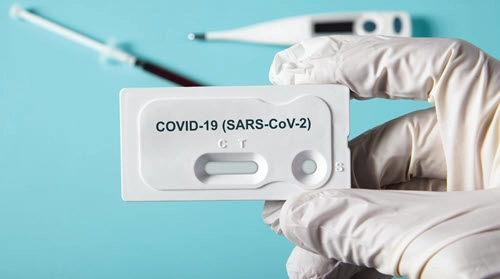Recap SARS-CoV-2 Lab Coding Options
3 categories get you to the right code. We’ve kept you abreast of nearly 25 new lab procedure codes for SARS-CoV-2 testing issued since February of last year, but that rapid-fire pace may have left your head spinning. Now you can clear your head with the following comprehensive accounting of those codes so you can grasp the options and make sure you choose the right code — every time. Key: Keep in mind that antigen testing identifies the presence of the SARS-CoV-2 virus and indicates an active COVID-19 infection, while antibody testing identifies the presence of antibodies to SARS-CoV-2 produced by the body in response to a past case of COVID-19. Group 1: Identify SARS-CoV-2 Antigens by NAT (87635, U0001, U0003, U0005, U0002) The first test approved to diagnose COVID-19 was a nucleic acid test (NAT) created by the Centers for Disease Control and Prevention (CDC). This test is reported with U0001 (CDC 2019 Novel Coronavirus (2019-nCoV) Real-Time RT-PCR Diagnostic Panel). Now: For a non-CDC NAT test that uses amplified probe technique, turn to 87635 (Infectious agent detection by nucleic acid (DNA or RNA); severe acute respiratory syndrome coronavirus 2 (SARS-CoV-2) (Coronavirus disease [COVID-19]), amplified probe technique). Before the advent of 87635 in March 2020, you might have used U0002 (2019-nCoV Coronavirus, SARS-CoV-2/2019-nCoV (COVID-19), any technique, multiple types or subtypes (includes all targets), non-CDC) for a non-CDC NAT test. High-throughput: If your lab performs a SARS-CoV-2 NAT test using high-throughput technologies, you should instead list U0003 (Infectious agent detection by nucleic acid (DNA or RNA); severe acute respiratory syndrome coronavirus 2 (SARS-CoV-2) (Coronavirus disease [COVID-19]), amplified probe technique, making use of high throughput technologies as described by CMS-2020-01-R). If you meet the criteria for a two-day turnaround, you should additionally report U0005 (Infectious agent detection by nucleic acid (dna or rna); severe acute respiratory syndrome coronavirus 2 (sars-cov-2) (coronavirus disease [covid-19]), amplified probe technique, cdc or non-cdc, making use of high throughput technologies, completed within 2 calendar days from date of specimen collection (list separately in addition to either hcpcs code u0003 or u0004) as described by cms-2020-01-r2). Group 2: Identify SARS-CoV-2 Antigens by Immunoassay or Other Methods (87426, 87811, U0004, U0005, U0002) If your lab identifies SARS-CoV-2 antigens by immunoassay, you have the following two codes to choose from: Distinction: “You should use 87426 for an instrumented immunoassay test, and reserve 87811 for a visually-read immunoassay test,” says William Dettwyler, MT-AMT, president of Codus Medicus, a laboratory coding consulting firm in Salem, Ore. U0002: Before you had codes 87426 and 87811, you may have used U0002 for a test for SARS-CoV-2 antigen detection by immunoassay. You may still use U0002 if your lab performs a non-CDC SARS-CoV-2 antigen test using a method that isn’t described by 87635, 87426, or 87811. High-throughput: If your lab performs a SARS-CoV-2 antigen test by any method other than NAT using high-throughput technologies, you should list U0004 (2019-nCoV Coronavirus, SARS-CoV-2/2019-nCoV (COVID-19), any technique, multiple types or subtypes (includes all targets), non-CDC, making use of high throughput technologies as described by CMS-2020-01-R.). You should add code U0005 if you meet the two-day turnaround guidelines. Group 3: Identify SARS-CoV-2 Antibodies (86413, 86769, 86328, 86408, 86409, 0224U, 0226U) CPT® provides the following three codes for SARS-CoV-2 antibody tests: Quantitative: For a test that measures the level of antibodies in the patient specimen, report 86413. Quantifying antibody level may enhance understanding of immune response to SARS-CoV-2 and impact prevention and treatment protocols. Codes 86769 and 86328 describe qualitative or semi-quantitative antibody tests distinguishable by lab method as a more complex test (86769) or a less complex test using a method such as a reagent strip. PLA: A proprietary laboratory analysis (PLA) code describes the COVID-19 Antibody Test from Mount Sinai: 0224U (Antibody, severe acute respiratory syndrome coronavirus 2 (SARS-CoV-2) (Coronavirus disease [COVID-19]), includes titer(s), when performed). Neutralizing: CPT® also added the following two codes for neutralizing antibody tests: More than determining if the patient had a past SARS-CoV-2 infection, the neutralizing antibody tests “determine if antibodies present in a patient specimen can directly block infection of cells expressing the viral entry receptor on their surface,” according to CPT® Assistant Special August 2020 Edition. Results of these tests may “help … identify optimal convalescent plasma donors and ultimately help assess the efficacy of anti-SARS-CoV-2 vaccines,” according to William Morice, II, MD, PhD, president of Mayo Clinic Laboratories in a news release. An 86408 test screens for the presence of neutralizing antibody(ies), such as antibodies to the SARS-CoV-2 spike protein involved in binding to a human cell receptor. An 86409 test measures the level of neutralizing activity of antibody(ies). PLA: You also have a PLA code for neutralizing antibodies: 0226U (Surrogate viral neutralization test (sVNT), severe acute respiratory syndrome coronavirus 2 (SARS-CoV-2) (Coronavirus disease [COVID-19]), ELISA, plasma, serum). Use this code only for Tru-ImmuneTM, Ethos Laboratories, from GenScript® USA, which uses a blood plasma or serum specimen to detect and quantify the presence (or absence) of SARS-CoV-2 neutralizing antibodies. More: To understand lab tests for multiple respiratory pathogen targets including SARS-CoV-2, see “Focus Respiratory Pathogen Panels with SARS-CoV-2” in this issue.

